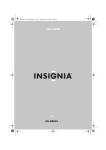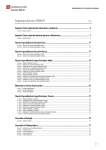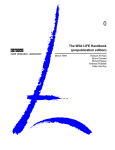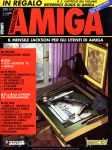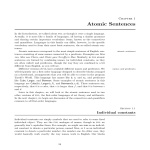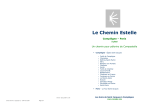Download A Graphical Toolkit in LIFE
Transcript
A Graphical Toolkit in LIFE Hassan AH-Kacit Bruno Dumant" April 12, 1995 Abstract LIFE is a programming language integrating different programming paradigms in the same framework, such as object orientation, concurrency and passive constraints. We have used this language to implement the prototype of a very basic and simple graphical toolkit for LIFE applications. This prototype is built on top of a basic interface between LIFE and the X Windows library It demonstrates that the combination of the different paradigms supported by LIFE is most adequate for designing such applications. Because the toolkit is all realized in LIFE, it could be easily ported to another window system (e.g., MS-Windows) provided the basic calls to the underlying window system are given as interface. 1 Introduction LIFE, an acronym for Logic, Inheritance, Functions, and Equations, is an experimental programming language designed after these four precepts for specifying structures and computations([3]. LIFE can also be seen as a specific instantiation of a Constraint Logic Programming (CLP) scheme with a particular constraint language; in its most primitive form, this constraint language constitutes a logic of record structures. In this paper, we mean to overview informally the functionality of LIFE and the conveniences that it offers for programming, and describe a simple toolkit to build interactive window-based applications in LIFE. It provides the user with some basic functionalities of bigger toolkits, in short the ability to use buttons, text fields, menus, and sliders. Comp-osite objects containing these primitives can be created arbitrarily at run-time. The prootype toolkit is built on top of a basic X interface that consists essentially in calls to the X library. The toolkit is organized around three concepts: boxes, looks, and constructors. • boxes are used to compute the sizes and positions of objects on the screen. ·INRIA (Domaine de Voluceau, Rocquencourt, B.P. 105, 78153 Le Chesnay Cedex, France). Bruno.Dumanttiiinria.fr tSimon Fraser University (School of computing science, Bumaby, British Columbia V5A IS6, Canada) [email protected] 1 1 61 • constructors are used to build and initialize screen objects. All objects that have a behavior (i.e. not simple graphical objects, but real widgets) inherit from one constructor type. • looks are used to describe the appearance of screen objects. An object may be a subtype of several look types and will inherit the appearance of these' 'looks" . In the next section, we give an overview of the LIFE language, then we shall focus on the toolkit and describe its implementation. 2 The LIFE language LIFE expressions are of three kinds: functional, relational, and structural. The functionoriented component of LIFE is directly derived from functional programming languages with higher-order functions as first-class objects, data constructors, and algebraic pattern-matching for parameter-passing. The convenience offered by this style of programming is one in which expressions of any order are first-class objects and computation is determinate. The relation-oriented component of LIFE is essentially one inspired by the Prolog language [5, 6]. Unification of first -order patterns used as the argument-passing operation turns out to be the key of a quite unique and hitherto unusual generative behavior of programs, which can construct missing information as needed to accommodate success. Finally, the most original part of LIFE is the structure-oriented component which consists of a calculus of type structures---the 'l,b-calculus [1, 2]---and accounts for some of the (multiple) inheritance convenience typically found in so-called object-oriented languages. The next subsection gives a very brief and informal account of the calculus of type inheritance used in LIFE ('l,b-calculus). The reader is assumed familiar with logic programming. 2.1 'l,b-Calculus In this section, we give an informal but informative introduction of the notation, operations, and terminology of the data structures of LIFE. It is necessary to understand the programming examples to follow, and the description of the toolkit. The 'l,b-calculus consists of a syntax of structured types called 'l,b-termstogether with subtyping and type intersection operations. Intuitively, as expounded in [4], the 'l,b-calculus is a convenience for representing record-like data structures in logic and functional programming more adequately than first-order terms do, without loss of the well-appreciated instantiation ordering and unification operation. Let us take an example to illustrate. Let us say that one has in mind to express syntactically a type structure for a person with the property, as expressed for the underlined symbol in Figure 1, that a certain functional diagram commutes. The syntax of 'l,b-terms is one simply tailored to express as a term this kind of approximate 1 62 2 person name id first last spous po use last person name id Figure 1: A commutative functional diagram description. Thus, in the 1j!-calculus, the information of Figure 1 is unambiguously encoded into a formula, perspicuously expressed as the 1j!-term: - => idlfirst => string, last => S : string), spouse => person (name => id( last => S), spouse => X)). X: personiname It is important to distinguish among the three kinds of symbols participating in a 1j!-term. We assume given a set S of sorts or type constructor symbols, a set F of features, or attributes symbols, and a set V of variables (or coreference tags). In the 1j!-term above, for example, the symbols person, id, string are drawn from S, the symbols name,jirst, last, spouse from F, and the symbols X, S from V. (We capitalize variables, as in Prolog.) A 1j!-term is either tagged or untagged. A tagged 1j!-term is either a variable in V or an expression of the form X : t where X E V is called the term's root variable and t is an untagged 1j!-term. An untagged 1j!-term is either atomic or attributed. An atomic 1j!-term is a sort symbol in S. An attributed 1j!-termis an expression of the form s( i 1 => tl, ... ,in => tn) where the root variable's sort symbol s E S and is called the 1j!-term's principal type, the ii's are mutually distinct attribute symbols in F, and the tj' s are 1j!-terms (n ~ 0). Variables capture coreference in a precise sense. They are coreference tags and may be viewed as typed variables where the type expressions are untagged 1j!-terms. Hence, as a condition to be well-formed, a 1j!-term must have all occurrences of each coreference tag consistently refer to the same structure. For example, the variable X in: personi id => nameifirst => string, last => X : string), father => person (id => name( last => X : string) ) ) 3 163 refers consistently to the atomic 1jJ-term string. To simplify matters and avoid redundancy, we shall obey a simple convention of specifying the sort of a variable at most once and understand that other occurrences are equally referring to the same structure, as in: => name (first => string, last => X : string), father => person ( id => name( last => X))) person (id In fact, since there may be circular references as in: X : person (spouse => person (spouse => X)) this convention is necessary. Finally, a variable appearing nowhere typed, as uijunkl; kind => X) is implicitly typed by a special greatest initial sort symbol T always present in S. This symbol will be written as the symbol @ as in @(age => integer, name => string). In the sequel, by 'l,b-termwe shall always mean well-formed 'l,b-term. Generalizing first-order terms.' 'l,b-termsare ordered up to variable renaming. Given that the set S is partially-ordered (with a greatest element T), its partial ordering is extended. to the set of attributed 1jJ-terms. Informally, a 1jJ-term tI is subsumed by a 1jJ-term tz if (1) the principal type of tI is a subtype in S of the principal type of t2; (2) all attributes of t2 are also attributes of tI with 1jJ-terms which subsume their homologues in tI; and, (3) all coreference constraints binding in tz must also be binding in tI. For example, if student < person and paris < cityname in S then the 'l,b-term: => name (first => string, last => X : string), lives..at => Y : address (city => paris), father => personiid => nameilast => X), lives...at => Y)) student( id is subsumed by the 1jJ-term: => nameilast => X: string), lives..at => address (city => cityname), father => person ( id => namel last => X))). personiid In fact, if the set S is such that greatest lower bounds (GLB's) exist for any pair of type symbols, then the subsumption ordering on 1jJ-term is also such that GLB' s exist. Such are defined as the unification of two 'l,b-terms. A detailed unification algorithm for 'l,b-terms is given in [4]. Consider for example the poset displayed in Figure 2 and the two f(1 IIn fact, if a first-order term is written f(ll, :::} tl, ... , n :::}tn). 1. [~4 '-' 1jJ-terms: ... ,tn), it is nothing other than syntactic sugar for the 1/>-term 4 Figure 2: A lower semi-lattice of sorts X : student( advisor => laculty( secretary => Y : staff, assistant => X), roommate => employeei representative => Y)) and: employee (advisor => 11(secretary => employee, assistant => U :person), roommate => V: studenti representative => V), helper e- Wl(spouse=> U)). Their unification (up to tag renaming) yields the term: W : workstudyi advisor => I1 (secretary => Z : workstudyi representative => Z), assistant => W), roommate => Z, helper => wl(spouse => W)). Last in this brief introduction to the 1j;-calculus, we explain type definitions. The idea is that types in the signature may be specified to have attributes in addition to being partially-ordered. Inheritance of attributes from all supertypes to a subtype is done in accordance with 1j;-term subsumption and unification. For example, given a simple signature for the specification of linear lists S = {list, cons, []} with [] < list and cons < list, this is expressed as: [J < cons 1 list. list. <I 5 1 65 In addition, it is possible to specify that cons has an attribute 2 ~ :: cons(2 list. This is expressed as: list). => In fact, it is possible to attach complex properties (attributes or arbitrary constraints) to sorts. These properties will be verified during execution, and also inherited by subsorts. A definition attaching attributes to a sort is expressed using the following syntax: :: sort (label '1j;-terrn, ... label => r => '1j;-terrn). For example, to express that "vehicles have a make that is a string, and a number of wheels that is an integer" we may write: :: vehicle(make string, number_of_wheels => => int). And to say that "cars are vehicles that have 4 wheels", we write: car <I vehicle. :: car(number_of_wheels => 4). Obviously if the relation car < I vehicle is asserted then any properties attached to car must be compatible with those attached to vehicle, otherwise type car would be l.. It is also possible to use functions in attribute definitions, for example: :: square(side => S:real,surface => S*S). One can also demand that certain constraints always hold about a sort. The syntax for this is: :: sort (attributes) 1 constraint. where constraint has the same form as that of a definite clause's body. The operator pronounced "such that. " For example: :: code(key => S:string) 1 is pretty_complicated(S). attaches a constraint to any object of sort code where pret ty _compl ica ted is a predicate expressing some property on strings. You might find it helpful to read this as "all codes have a key that is a string, S, such that S is pretty complicated. " In fact, the "such that" operator I may be used not only in sort definitions but as with arbitrary terms in functions and predicate definitions. It is a function in that the expression El G (pronounced "E such that G") evaluates the expression E, then proves the goal G, and finally returns the value E in the c's solution context. For example, the 'l/J-term conjunction operator & is defined as the following (infix) function: X & Y -> X 1 x = Y. 1(:,6 Iv 6 2.2 Functions and suspensions in LIFE In LIFE, a basic 1j;-termdenotes a functional application if its root symbol is a defined function. An example of such is append ( list, L), where append is the function defined as:2 append(n, L : list) -+ L. append([HIT: list], L: list) -+ [Hlappend(T, L)]. The 1j;-term fooibar =? X : list, ba: =? Y : list.fuz =? appendl X, Y)) is one in which the attribute fu: is derived as a function of the attributes bar and baz: Unifying such 1j;-terms proceeds modulo suspension of functional expressions whose arguments are not sufficiently refined to be provably subsumed by patterns of function definitions. For instance, the equation X = append(Y,Z) will be suspended until Y is bound to a 1j;-term subsumed by [] or [@Ilist), and Z by a 1j;-term subsumed by list. Arithmetic functions in particular are implemented as functions that will suspend until their arguments are bound to numbers. This gives the power of passive constraints to the language, which will be extensively used in the following to express placement constraints between objects. Another important application of this suspension mechanism is the ability to mimic concurrent processes that may communicate thanks to the logical variables. Consider for instance the two functions: process_l([lINXl,Y) process_2([2INYl,X) -> -> process_l(NX,NY) process_2(NY,NX) Y x [2INY] . [lINX] . with the query: process_l(X,Y), process_2([2IY] ,X) ? The execution first suspends process_1 since its arguments are not sufficiently instantiated. Then it calls process_2, which can be executed. Its execution first suspends the recursive call to process_2, then binds X to [11NX].By doing this, the call to process_1 will be released, and its execution will suspend a new call to process_1, and release the suspended call to process_2. Thus, we have two processes synchronized thanks to their arguments. This mechanism is used in the toolkit to deal with events. An event handler is a recursive function that waits for events, is released when an event occur, and reinstalls itself after having performed the right actions. 3 A Graphical Toolkit in LIFE As we have seen in the introduction, the toolkit we describe now is organised around three concepts: boxes, constructors, and looks. These three concepts are represented by sorts in the 2For convenience, LIFE adopts the list syntax of Prolog. The notation [A I Bl is syntactic sugar for the term cons (A, B), which is itself a shorthand for the 'l/J-tenn cons (l=>A, 2=>B). 7 167 process.Z release 1 suspend 2 suspend 1 release 2 implementation, which we detail in the next subsections. 3.1 Boxes and placement constraints 3.1.1 Definition of boxes The basic concept used in this toolkit is that of a box. A box resembles very much the box concept used by TeX. They have been introduced in the toolkit to let the developper of an application describe simply the position constraints between the objects of the interface. The passive constraints of LIFE are then used to compute the actual position parameters of the boxes satisfying these constraints. All the objects manipulated by the toolkit are boxes. A box is defined by the following type decIaration: :: box (X, Y width I => DX, height => DY border I => B) .. x and Y are integers giving the coordinates of the box, DX and DY are integers giving the dimensions of the box. The border feature is the width of reserved space on each side of a box. When a box is declared, the user need not specify all these parameters. Some of them have (customizable) default values, others may be computed thanks to constraints defined over boxes. We describe in the following the basic constraints offered by the tool kit. These primitives just set and try to resolve the placement constraints. 1 68 8 3.1.2 Constraints on boxes Relative positioning The toolkit offers a number of primitives to place boxes. They are functions taking two boxes as arguments and returning the smallest box containing these arguments placed in a certain way. For instance Boxl l_above Box2 returns the smallest box containing Boxl and Box2,such that: • Box 1 is above Box2, and • their left sides are aligned. Containment "Boxl contains Box2" expresses that Boxl contains Box2. Ifno size is specified for Boxl, it will be given the same size as that of Box2. If Boxl has a border feature worth Border, it will be used to reserve a space ofthat width around the box. In this case, Boxl will be larger than Box2. Refined positioning Boxl There are also some primitives that set finer constraints. For instance: lr_aligned Box2 will force the left side of Boxl to be aligned with the right side of Box2 . will force the centers of Boxl and Box2 to be vertically aligned. Sizes of boxes It is very useful to be able to constrain some boxes to have the same size. same_size (List_of_Boxes) will force all the boxes of the list to have the same height and width. When boxes contain text, their sizes are computed on the fly, using a subsort of box: t_box. If no size is already given for a box, and if it is a sub type of t_box, then its size is computed according to the text, the font used, and the space to be reserved around it (which are declared as features of t_box). These constraints may be cumulated and imposed in any order. The local constraint propagation of LIFE guarantees that if the constraints are consistent and enough information exists to determine a placing, it will be determined. If the constraints are inconsistent, then they will fail and cause backtracking. 9 1 69 3.2 Constructors: Describing the behavior of widgets 3.2.1 Constructor types A constructor type defines the behavior of a family of widgets, and defines the methods to initialize them by creating the windows and setting up the event handlers. Let us take the example of the constructor of text field widgets. It is defined as follows: text_field_c <I box. :: A:text_field_c( on => bool, text => string, action => Action, constructor => build_text_field(A)). The on feature determines the state of the button, text its text, action the action to be performed when a new text is entered, and cons truc tor the method used to actually create a text field. Creating a text field consists in initializing the first features, creating a window, and setting up an event handler for this window. build_text_field(Button) :create_subwindow(Button) , Button.on «false, initialize_action (Button) , initialize_text (Button) , catch_text_field_events(Button) . Bu t t on .on designates the on feature of Bu t t on. The < < - sign is a permanent assignment, which means that this value won't be modified on backtracking. 3.2.2 Handling events Events are handled thanks to the ability of LIFE to express implicitly concurrent processes. Communication with X is handled by the xGetEvent function. This function takes two arguments, a window and a mask, and suspends until an event matching the mask occurs in the window. catch_events (Button) -> true Event = get_event( ... ), handle_event (Event) . handle_event (rnouse_event) -> true (actions) Event = get_event( ... ), handle_event (Event) . 170 1 10 I!li I 1 look I I ---------r----=-----, _________fieldI ~ text..box frame 1 1 I 1 1 text-field.1 1 I Figure 3: text field look Events are implemented as sorts (mouse_event, expose_event, ... ) An event handler is implemented as a recursive function that performs some actions when an event of the proper sort occurs, and reinstalls itself afterwards. 3.3 Looks The look of a box is also handled through inheritance. For instance, the sort describing the appearance of a text field --- text_field_l --- is a sub sort of text_box, field and frame, each of these sorts describing a special look feature. The idea is to have specific types to which some specific drawing methods are attached. As there is no such thing as overriding in LIFE, inheritance is not handled as usual. Drawing methods are described thanks to two predicates: draw_static and draw_dynamic. draw_static is just used once, when the box is drawn forthe first time. draw_dynamic is used each time the state of the widget changes, to redraw it according to its new state. A special control mechanism is used to draw widgets. It is important here to make sure that all the drawing methods defined for a look will be used each time it is necessary. To do this, the drawing predicate calls draw_static and draw_dynamic with matching (and not unification) and backtracks until no method can any more be used. 3.4 Screenobjects The screen objects manipulated by the X toolkit are subsorts of .Iooks and/or constructors. They usually have an additional feature that stipulates how the states of the look and that of the constructor are linked (change_state). All these mixed paradigms make it very easy to design interfaces. It is also very easy to add new objects to the toolkit. For instance, a user that wants to define a slider that contains text can do it easily this way: rny_slider rny_slider rny_slider <I <I <I h_slider_c. frame. field. 11 1 71 These declarations just stipulate that my_s 1 i der has the behavior of an horizontal slider, and the look of a frame, a field, and a text box. Now, imagine the user wants to use it in an interface where the value of a text field is related to that of the slider, and the text' 'DANGER" must appear on the slider if the value is too big. This will be turned into the following code: make_interface (Panel) :Button = text_field_button(text => "100", action => set_slider(Button,Slider)), => 200) SlideBar slide_bar(width contains => 0, max => 100, Slider : my_slider(min text => "DANGER", action => set_text(Slider,Button)), Panel : panel contains Button c_left_of SlideBar. set_slider(Button,Slider) :Value = parse (Button. text) , cond(Value :< real, cond(Value >= Slider.min and Value =< Slider.max, (move_slider(Slider,Value), check_danger(Slider)))). set_text (Slider,Button) :Button.text «- int2str(floor(Slider.value)), refresh_look (Button) . check_danger (Slider) :cond( Slider.value >= 80, "DANGER", Slider.text «."), Slider.text «refresh_look (Slider) . make_interface defines the layout of the interface and its objects. The text in the text field (resp. the position of the slider) is modified by set_text (resp. set_slider) when the position of the slider (the text) is modified. Both call check_danger that changes the text of the slider according to its value. 4 Conclusion We have shown in this paper how the different programming paradigms of LIFE may be used to simplify the design of the basic mechanisms of a graphical toolkit. Constraints are used to deal with the placement of boxes, inheritance to deal with the looks of widgets, suspension to easily design event handlers. The central data structure of LIFE, the 'I{I-termseems to be really 12 well-suited for the modelling of objects such as those needed in graphical interfaces. What has made this toolkit so easy to build is the simultaneous presence of these paradigms in the same language. To give an idea of the conciseness of the implementation, this toolkit is only 2200 lines long. The main limitations of this prototype come from the speed limitations of the LIFE interpreter itself, and the number of available functionalities of the basic X libraries interfaced with LIFE. Nevertheless, it should be very easy to extend. This toolkit has been used with great ease to build the X interfaces of some of the example programs of the LIFE system. One can retrieve the system and use it from the World Wide Web URLhttp://www.isg.sfu.callife/ . References [1] Hassan Ait-Kaci. A Lattice-Theoretic Approach to Computation Based on a Calculus of Partially-Ordered Types. PhD thesis, University of Pennsylvania, Philadelphia, PA, 1984. [2] Hassan Ait-Kaci. An algebraic semantics approach to the effective resolution of type equations. Theoretical Computer Science, 45:293--351, 1986. [3] Hassan Ait-Kaci, Bruno Dumant, Richard Meyer, Andreas Podelski, and Peter Van Roy. The wild life handbook, a user manual. Technical report, Digital Equipment Corporation, Paris Research Laboratory, Rueil-Malmaison, 1994. (prepublication edition). [4] Hassan Ait-Kaci and Roger Nasr. LOGIN: A logic programming language with built-in inheritance. Journal of Logic Programming, 3:185--215,1986. [5] William F. Clocksin and Christopher S. Mellish. Programming in Prolog. Springer- Verlag, Berlin, Germany, 2nd edition, 1984. [6] Richard O'Keefe. The Craft of Prolog. MIT Press, Cambridge, MA, 1990. 13 173













